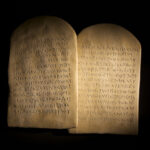A God of Order in a World of Chaos
We live in a world that feels increasingly chaotic – morally, politically, spiritually. Truth is often subjective, justice is debated, and order feels like a distant memory. Yet from the first words of Scripture, we’re introduced to a God whose very nature is the opposite of confusion. The Bible doesn’t begin with uncertainty, but with intention: “In the beginning, God created…” What follows is not randomness, but careful structure – light separated from darkness, land from sea, life formed with purpose. But just one verse later, something feels out of place: “The earth was without form and void, and darkness was over the face of the deep.” How could a perfect God begin with such chaos?
This question leads us to a profound truth – one echoed from Genesis to Revelation: God brings order out of disorder, peace out of chaos, and restoration where there has been devastation. What we see in the opening lines of the Bible isn’t a flaw in creation, but a hint of something deeper. It’s the pattern of God’s work throughout history, and it’s still unfolding today.
God Is a God of Order
From beginning to end, Scripture consistently affirms that God is a God of order, structure, and purpose. Whether in the heavens above or in the laws given to Israel, His divine fingerprints reveal a mind of wisdom, clarity, and peace – not confusion. His commandments were not arbitrary, but intended “for [our] wisdom and understanding in the sight of the peoples” (Deuteronomy 4:6–8). In nature, we see mathematical precision, balance, and beauty. In governance, we see hierarchy and design. As Paul later wrote, “the heavens declare the glory of God; the skies proclaim the work of His hands” (Psalm 19:1), and creation itself reveals His eternal power and divine nature (Romans 1:20).
When God creates, the result is “good.” The book of Job gives a glimpse behind the curtain, describing the moment of creation with poetic awe: “Where were you when I laid the foundations of the earth… when the morning stars sang together, and all the sons of God shouted for joy?” (Job 38:4–7). This celebration implies a creation that was perfect – complete, structured, and worthy of praise.
But then we read the second verse of the Bible.
“The earth was without form, and void; and darkness was on the face of the deep” (Genesis 1:2, NKJV).
The Hebrew phrase tohu va-bohu – “formless and void” – suggests something more than an unshaped lump of matter. In other places in Scripture, this phrase points to devastation and judgment (see Jeremiah 4:23). Yet Isaiah 45:18 clearly tells us that “God did not create it empty [tohu]; He formed it to be inhabited.”
If God is a God of order, why would His creation begin in a state of desolation? Why would the earth be described as uninhabitable and shrouded in darkness? Genesis 1:1 presents a picture of majestic creation – “In the beginning, God created the heavens and the earth” – but verse 2 seems to pivot to a scene of chaos and ruin. How do we reconcile this?
Many have concluded that these two verses describe two distinct events. Genesis 1:1 depicts the original, perfect creation, while verse 2 describes the condition of the earth after a catastrophe. The six days of creation that follow are not the initial creation of the universe, but a restoration of a world that had fallen into chaos.
A Rebellion Before the Restoration
If God’s creative work is good, ordered, and praiseworthy – as Scripture consistently shows – then Genesis 1:2 stands out like a riddle. Why would the very next verse describe the earth as “formless and void,” cloaked in darkness and submerged in the deep? It appears to contradict the nature of the Creator Himself.
But the Bible does not leave this question unanswered.
Clues scattered across Scripture point to a dramatic event between the original creation and the six-day restoration. The prophets Isaiah and Ezekiel pull back the curtain on a rebellion that took place in the heavenly realm. In Isaiah 14:12–15, we read about a being once called “Lucifer, son of the morning,” who sought to exalt himself above God. Likewise, Ezekiel 28:12–17 describes a “covering cherub” in Eden, perfect in beauty and wisdom, until “iniquity was found” in him. His pride led to his downfall.
Jesus Himself confirmed the reality of this cosmic rebellion when He declared, “I saw Satan fall like lightning from heaven” (Luke 10:18). These events – an angelic uprising and divine judgment – must have occurred before the creation of Adam and Eve. This timeline matters. In Job 38, the angels (referred to as “sons of God”) rejoiced at the creation of the earth, which means that Lucifer had not yet fallen when God originally created the heavens and the earth. The fall came after that moment of joy – but before the formless state described in Genesis 1:2.
The implication is profound: something happened between verse 1 and verse 2. The earth did not begin in chaos – it became chaotic. The Hebrew word translated “was” in Genesis 1:2 (hayetah) can also mean “became,” and in many contexts it clearly does (e.g., Genesis 19:26; Exodus 7:19). If the earth became formless and void, it may have done so as the result of judgment – possibly related to the angelic rebellion.
This view is sometimes called the “Gap Theory,” but that label can be misleading. It’s not about squeezing millions of years into the text to satisfy science – it’s about preserving the integrity of Scripture and God’s character. It upholds what we know of God’s nature: He does not create disorder, He judges it. He does not bring darkness, but light. He does not form chaos, but restores it.
From the Surface: A Viewpoint of Restoration
The second verse of Genesis gives us a mysterious but vivid image:
“The earth was without form, and void; and darkness was on the face of the deep. And the Spirit of God was hovering over the face of the waters.”
Here we’re given a perspective, a key to understanding what’s called, ‘Creation Week‘ – what is described is from the perspective of the surface of the earth. The Spirit of God is pictured hovering, not far above a planet, but over a dark, water-covered world. It’s a world enshrouded in judgment, like the aftermath of a great catastrophe.
Some scholars and scientists suggest that this darkness was not the absence of celestial light, but the result of a thick, toxic atmosphere that completely blocked visibility from the earth’s surface. Think of the ash and gas that follow a massive volcanic eruption – or worse, a global-scale event. If a rebellion had occurred, if God had judged the earth with destruction, what we see in verse 2 would very well be the aftermath.
When God said, “Let there be light,” He wasn’t necessarily creating light itself – light already existed. Instead, He was allowing it to penetrate the dense atmosphere, beginning the process of restoration. The light became visible from the earth’s surface. This interpretation brings clarity to a long-debated issue: if the sun and stars weren’t “made” until day four, how was there light on day one?
The logical explanation is that the heavenly bodies were already in existence – created “in the beginning” (Genesis 1:1) – but remained obscured from view. It was only on the fourth day that they became fully visible from the surface of the earth, as the atmosphere continued to clear. Astrophysicist Hugh Ross supports this understanding, noting that scientific evidence aligns with the biblical account when properly interpreted. This moment was not the creation of the sun, moon, and stars ex nihilo, but rather their appointment as timekeepers to govern signs, seasons, days, and years (Genesis 1:14–19).
This understanding also opens the door to the possibility of pre-Adamic life – forms of life that existed before the rebellion and judgment described between verses 1 and 2. The fossil record speaks of entire ecosystems and extinct species, buried in layers of rock and sediment. If such life existed in an earlier age, it fits naturally with a restoration view. The chaos of Genesis 1:2 could mark not the beginning of creation, but the end of a former world.
In this light, Genesis is not simply a story of beginnings – it is a story of beginnings after ruin. And that’s a story humanity knows all too well.
The God Who Restores What Sin Destroys
Genesis 1 gives us more than a record of creation – it reveals a core truth about God’s character: He is a restorer. When devastation strikes, God moves to bring peace, structure, and life. The pattern established in the first verses of the Bible continues throughout all of Scripture – God consistently brings restoration out of chaos and judgment.
Consider the nation of Israel. When they were enslaved in Egypt, God delivered them not merely to freedom, but to relationship – a people set apart by His law, brought into covenant with Him. That law, often misunderstood, wasn’t about rigid legalism. It revealed God’s character – His justice, mercy, and order. It laid out a way of life that restored harmony between individuals and with God. It was, and remains, a path to restoration.
Even when Israel fell into idolatry and rebellion, God’s response wasn’t permanent rejection. Through the prophets, He warned of judgment but also promised healing, return, and future glory. The recurring theme was clear: sin brings destruction, but God’s intent is always restoration.
This long arc of restoration reaches a critical moment in the coming of the Messiah. His first coming was not the end of the story but a turning point – He came to bear the burden of sin, to open access to the Father, and to reveal God’s plan more fully. But this was not the climax. The gospel is not complete in the cross alone – it points forward to His return, to the restoration of all nations under His rule, and to the establishment of His Kingdom on earth.
The Spirit of God – the same Spirit that hovered over the waters in Genesis – still works today. The power and presence of God active in the world. It works in those being called now, preparing a people to assist in that coming restoration. And one day, that restoration will go global.
The earth again finds itself on the brink – morally, spiritually, and environmentally. Humanity continues to repeat the same rebellion, and once more, the consequences are unfolding. But God is consistent. Just as He intervened in the beginning, and throughout history, He will do so again. As Revelation declares:
“Behold, I make all things new” (Revelation 21:5).
This is the hope that runs through the entire Bible – not simply forgiveness, but renewal. Not just individual salvation, but global restoration. God is a God of order, peace, and purpose. And every time sin brings the world to the edge of ruin, God’s response is the same: restore it.
Let There Be Light Again
The words spoken in Genesis 1:3 – “Let there be light” – marked the turning point in a world covered in darkness and chaos. That moment wasn’t just about photons breaking through a murky sky. It was about purpose being reignited. God was restoring what had been lost. Bringing light – clarity, truth, order – into a world that had become formless, empty, and judged.
That same pattern has echoed throughout time.
When Israel cried out in the darkness of Egypt, God said, in effect, Let there be light. When His people stumbled in the wilderness, built golden calves, and wandered from His ways, He sent judges, kings, and prophets to call them back – to shine light again. When the religious leaders of Jesus’ day had buried God’s law under tradition, and the people sat in spiritual darkness, He sent His Son – not just to teach or die, but to embody the coming Kingdom and say once again, Let there be light.
And today, we live in a time much like that original moment in Genesis 1:2. The world is filled with confusion, lawlessness, and spiritual void. People are searching for meaning, but turning to chaos instead. Truth is cast down. Even in religion, much of what is taught obscures God’s purpose and replaces His plan with manmade traditions or hollow promises.
Yet God has not changed.
The restoration He began at creation continues. The Messiah will return – not to start over, but to finish what He began. He will establish His Kingdom and restore peace, justice, and order to a world on the edge of destruction. The chaos of sin will be judged, and the earth – once again – will be filled with light.
Until then, that light shines in those being called today. The same Spirit that hovered over the waters hovers now in the hearts and minds of those who yield to God’s purpose. Just as God brought form to the formless and peace to the storm, He does the same in each life He touches. We are being restored – and prepared to help restore the world.
“For it is the God who commanded light to shine out of darkness, who has shone in our hearts…” (2 Corinthians 4:6)
From Genesis to Revelation, the message is the same: God is a God of order, of restoration, and of hope. In a world spiraling toward ruin, He still speaks – and when He does, the darkness cannot remain.
Let there be light – again.


